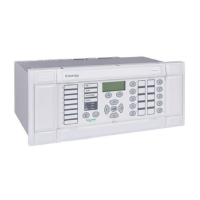P54x/EN AP/La4 Application Notes
(AP) 6-40
MiCOM P543, P544, P545 & P546
AP
2.9.1 Negative phase sequence current threshold, '2> current set'
The current pick-up threshold must be set higher than the negative phase sequence current
due to the maximum normal load unbalance on the system. This can be set practically at the
commissioning stage, making use of the relay measurement function to display the standing
negative phase sequence current, and setting at least 20% above this figure.
Where the negative phase sequence element is required to operate for specific uncleared
asymmetric faults, a precise threshold setting would have to be based upon an individual
fault analysis for that particular system due to the complexities involved. However, to ensure
operation of the protection, the current pick-up setting must be set approximately 20% below
the lowest calculated negative phase sequence fault current contribution to a specific remote
fault condition.
2.9.2 Time delay for the NPS overcurrent element, ‘2> tim
e delay’
As stated above, correct setting of the time delay for this function is vital. It should also be
noted that this element is applied primarily to provide back-up protection to other protective
devices or to provide an alarm. Hence, in practice, it would be associated with a long time
delay.
It must be ensured that the time delay is set greater than the operating time of any other
protective device (at minimum fault level) on the system which may respond to unbalanced
faults.
2.9.3 Directionalizing the negative phase se
quence overcurrent element
Where negative phase sequence current may flow in either direction through a relay location,
such as parallel lines, directional control of the element should be employed. Directionality is
achieved by comparison of the angle between the negative phase sequence voltage and the
negative phase sequence current and the element may be selected to operate in either the
forward or reverse direction. A suitable relay characteristic angle setting (2> Char Angle) is
chosen to provide optimum performance. This setting should be set equal to the phase
angle of the negative sequence current with respect to the inverted negative sequence
voltage (– V2), in order to be at the center of the directional characteristic.
The angle that occurs between V2 and 2 under fault conditions is directly dependent upon
the negative sequence source impedance of the system. However, typical settings for the
element are as follows;
For a transmission system the RCA should be set equal to -60°
For a distribution system the RCA should be set equal to -45°
For the negative phase sequence directional elements to operate, the relay must detect a
polarizing voltage above a minimum threshold, 2> V2pol Set. This must be set in excess of
any steady state negative phase sequence voltage. This may be determined during the
commissioning stage by viewing the negative phase sequence measurements in the relay.
2.10 Undervoltage protection
In the m
ajority of applications, undervoltage protection is not required to operate during
system earth (ground) fault conditions. If this is the case, the element should be selected in
the menu to operate from a phase to phase voltage measurement, as this quantity is less
affected by single phase voltage depressions due to earth faults. The measuring mode (ph-N
or ph-ph) and operating mode (single phase or 3 phase) for both stages are independently
settable.
The voltage threshold setting for the undervoltage protection should be set at some value
below the voltage excursions which may be expected under normal system operating
conditions. This threshold is dependent upon the system in question but typical healthy
system voltage excursions may be in the order of -10% of nominal value.
Similar comments apply with regard to a time setting for this element, i.e. the required time
delay is dependent upon the time for which the system is able to withstand a depressed
voltage.

